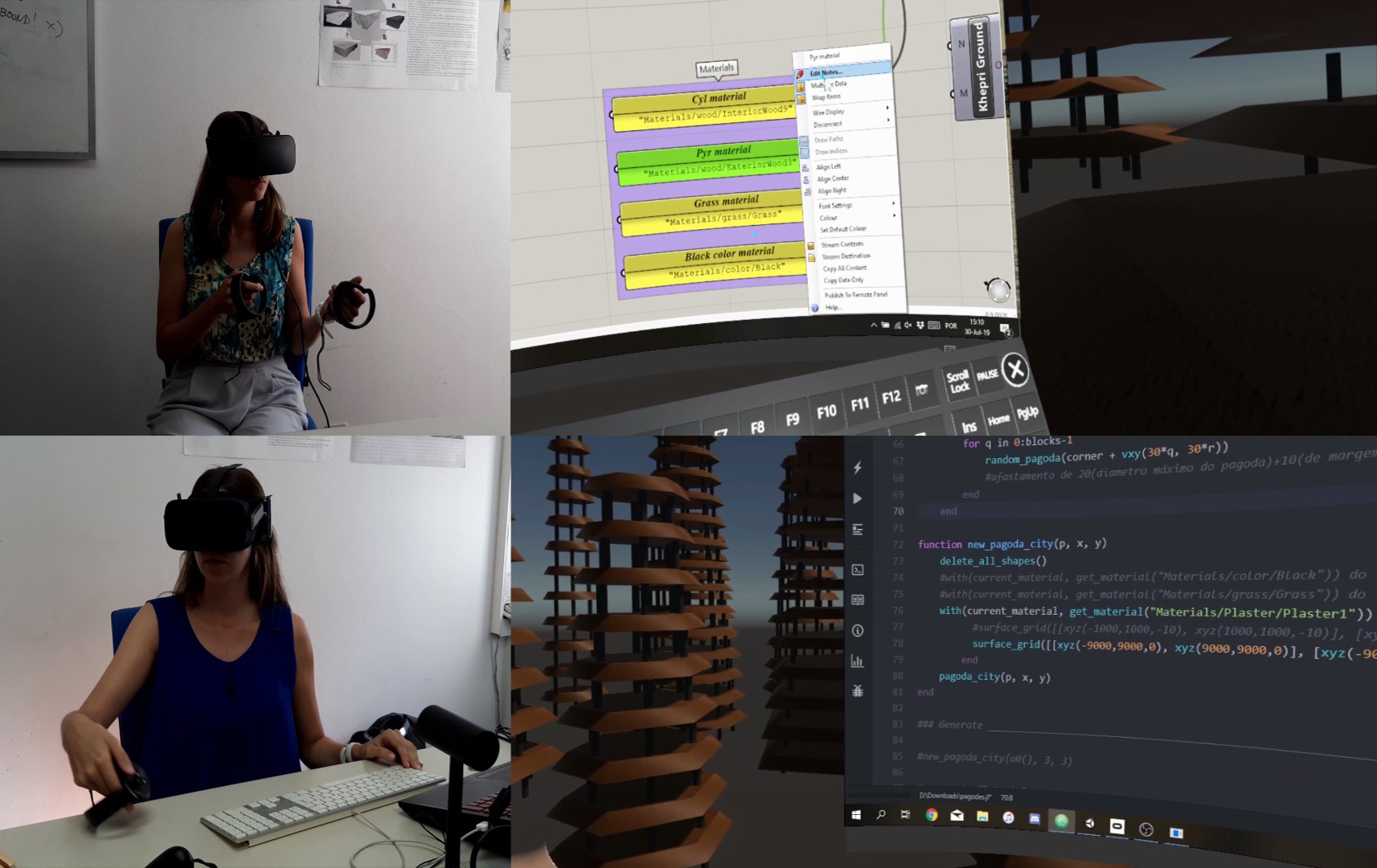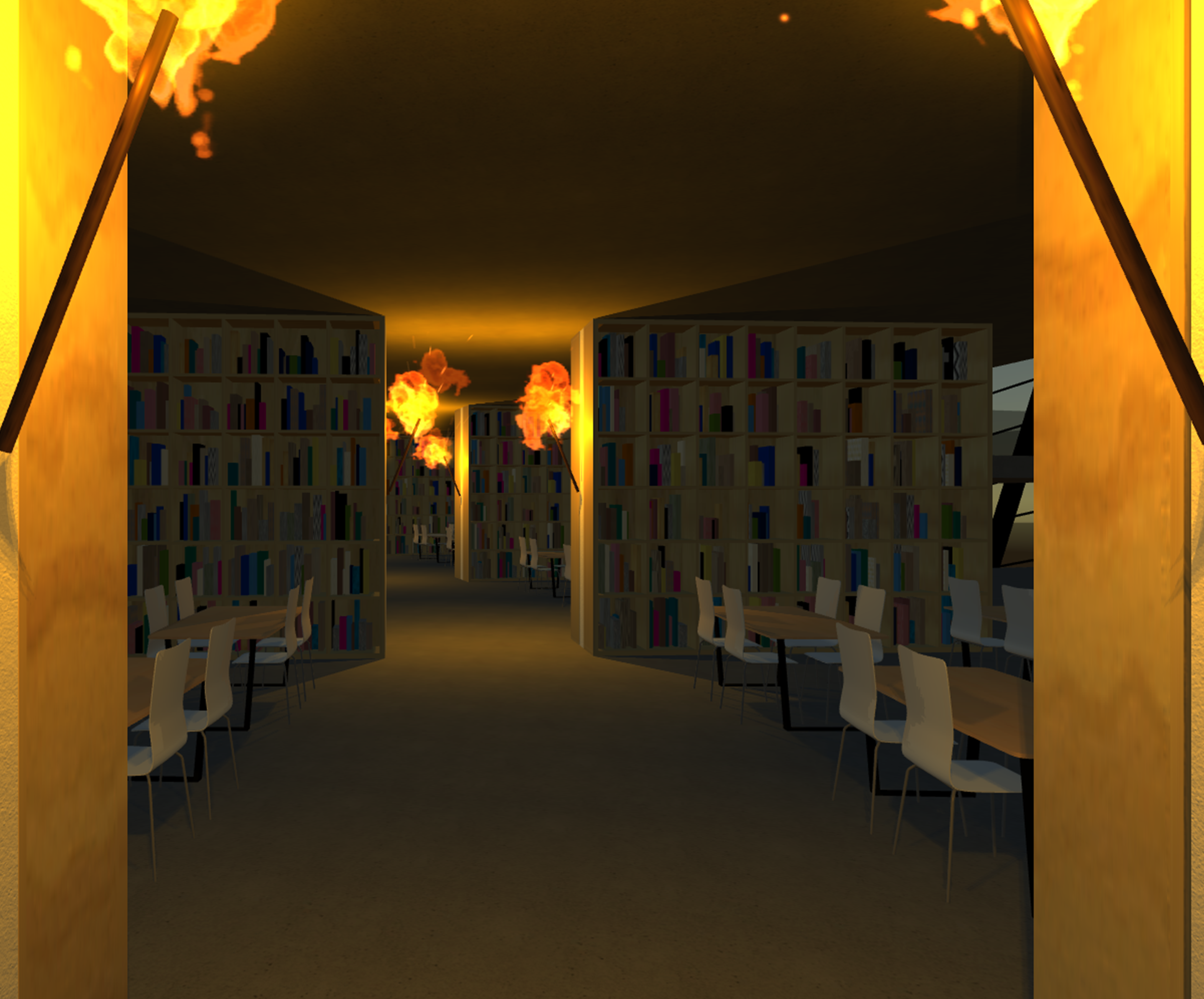Game Engines &
Virtual Reality
Publications
Algorithmic Design in Virtual Reality
Architecture - MDPI, 2022
Renata Castelo-Branco & António Leitão
 Abstract: Virtual reality has been shown to facilitate perception and navigation inside 3D models,
while stimulating creativity and enhancing architect/client interaction. In this scenario, in order to
better explore paths along the design space that are suggested from this interaction, it is important
to support quick updates to the model while still immersed in it. Algorithmic design, an approach
to architectural design that uses parametric algorithms to represent a design space, rather than a
single design instance, provides such support. We present a novel architectural design process
based on the integration of live coding with virtual reality, promoting an immersive approach to
algorithmic design. The proposed workflow entails the use of an algorithmic design tool embedded
in a virtual environment, where the architect not only creates the design but also interacts with
said design, changing it by live coding its algorithmic representation from within virtual reality.
In this paper, we explain the challenges faced and solutions devised for the implementation of the
proposed workflow. Moreover, we discuss the applicability of algorithmic design in virtual reality
to different stages of the architectural design process and the future developments that may arise
from this proposal.
Abstract: Virtual reality has been shown to facilitate perception and navigation inside 3D models,
while stimulating creativity and enhancing architect/client interaction. In this scenario, in order to
better explore paths along the design space that are suggested from this interaction, it is important
to support quick updates to the model while still immersed in it. Algorithmic design, an approach
to architectural design that uses parametric algorithms to represent a design space, rather than a
single design instance, provides such support. We present a novel architectural design process
based on the integration of live coding with virtual reality, promoting an immersive approach to
algorithmic design. The proposed workflow entails the use of an algorithmic design tool embedded
in a virtual environment, where the architect not only creates the design but also interacts with
said design, changing it by live coding its algorithmic representation from within virtual reality.
In this paper, we explain the challenges faced and solutions devised for the implementation of the
proposed workflow. Moreover, we discuss the applicability of algorithmic design in virtual reality
to different stages of the architectural design process and the future developments that may arise
from this proposal.
Inside the Matrix: Immersive Live Coding for Architectural Design
International Journal of Architectural Computing - SAGE Publications, 2021
Renata Castelo-Branco & Catarina Brás & António Leitão
 Abstract: Algorithmic Design (AD) uses computer programs to
describe architectural models. These models are visual by nature and, thus, greatly
benefit from immersive visualization. To allow architects to benefit from the
advantages of Virtual Reality (VR) within an AD workflow, we propose a new design
approach: Live Coding in Virtual Reality (LCVR). LCVR means that the architect
programs the design while immersed in it, receiving immediate feedback on the
changes applied to the program. In this paper, we discuss the benefits and impacts
of such an approach, as well as the most pressing implementation issues, namely the
projection of the programming environment onto VR, and the input mechanisms to
change the program or parts of it. For each, we offer a critical analysis and
comparison of the various solutions available in the context of two different
programming paradigms: visual and textual.
Abstract: Algorithmic Design (AD) uses computer programs to
describe architectural models. These models are visual by nature and, thus, greatly
benefit from immersive visualization. To allow architects to benefit from the
advantages of Virtual Reality (VR) within an AD workflow, we propose a new design
approach: Live Coding in Virtual Reality (LCVR). LCVR means that the architect
programs the design while immersed in it, receiving immediate feedback on the
changes applied to the program. In this paper, we discuss the benefits and impacts
of such an approach, as well as the most pressing implementation issues, namely the
projection of the programming environment onto VR, and the input mechanisms to
change the program or parts of it. For each, we offer a critical analysis and
comparison of the various solutions available in the context of two different
programming paradigms: visual and textual.
Parametric Model Manipulation in Virtual Reality: Lowering the Barriers of Algorithmic Design in Remote Collaboration
ACADIA Conference: Distributed Proximities
Online + Global, 2020
Catarina Brás & Renata Castelo-Branco & António Leitão
 Abstract: Algorithmic Design (AD) uses algorithms to describe architectural designs, producing
results that are visual by nature and which greatly benefit from immersive visualization.
Having this in mind, several approaches have been developed that allow architects to
access and change their AD programs from Virtual Reality (VR). However, programming
in VR introduces a new level of complexity that hinders creative exploration. Solutions
based in visual programming offer limited parameter manipulation and do not scale well,
particularly when used in a remote collaboration environment, while those based in textual
programming struggle to find adequate interaction mechanisms to efficiently modify
existing programs in VR.
Abstract: Algorithmic Design (AD) uses algorithms to describe architectural designs, producing
results that are visual by nature and which greatly benefit from immersive visualization.
Having this in mind, several approaches have been developed that allow architects to
access and change their AD programs from Virtual Reality (VR). However, programming
in VR introduces a new level of complexity that hinders creative exploration. Solutions
based in visual programming offer limited parameter manipulation and do not scale well,
particularly when used in a remote collaboration environment, while those based in textual
programming struggle to find adequate interaction mechanisms to efficiently modify
existing programs in VR.
This research proposes to ease the programming task for architects who wish to develop
and experiment with collaborative textual-based AD in VR, by bringing together the
user-friendly features of visual programming and the flexibility and scalability of textual
programming. We introduce an interface for the most common parametric changes that
automatically generates the corresponding code in the AD program, and a hybrid programming
solution that allows participants in an immersive collaborative design experience to
combine textual programming with this new visual alternative for the parametric manipulation
of the design. The proposed workflow aims to foster remote collaborative work in
architecture studios, offering professionals of different backgrounds the opportunity to
parametrically interact with textual-based AD projects while immersed in them.
Program Comprehension for Live Algorithmic Design in Virtual Reality
<Programming> Conference: New Interfaces for Programming
Porto, Portugal, 2020
Renata Castelo-Branco & António Leitão & Catarina Brás
 Abstract: Algorithmic Design (AD) is a design approach based on the
development of computer programs to describe architectural models. The programs’
outputs are digital architectural 3D models, which are visual by nature and,
therefore, benefit from immersive visualization. Live Coding in Virtual Reality
(LCVR) is a methodology for the interactive development of AD programs while
immersed in Virtual Reality (VR), favoring a more intuitive development process for
architectural designs. However, complex buildings tend to require complex AD
programs and, despite the added visual aid, as programs grow in complexity, it
becomes harder to understand which parts of the program were responsible for which
parts of the model. Moreover, LCVR introduces a new level of complexity: interaction
with both model and program in VR. This research proposes to ease the programming
task for architects who wish to code their models in VR, by supporting program
comprehension in the LCVR workflow with traceability and refactoring mechanisms.
These features will help users interact with their designs from within the virtual
environment.
Abstract: Algorithmic Design (AD) is a design approach based on the
development of computer programs to describe architectural models. The programs’
outputs are digital architectural 3D models, which are visual by nature and,
therefore, benefit from immersive visualization. Live Coding in Virtual Reality
(LCVR) is a methodology for the interactive development of AD programs while
immersed in Virtual Reality (VR), favoring a more intuitive development process for
architectural designs. However, complex buildings tend to require complex AD
programs and, despite the added visual aid, as programs grow in complexity, it
becomes harder to understand which parts of the program were responsible for which
parts of the model. Moreover, LCVR introduces a new level of complexity: interaction
with both model and program in VR. This research proposes to ease the programming
task for architects who wish to code their models in VR, by supporting program
comprehension in the LCVR workflow with traceability and refactoring mechanisms.
These features will help users interact with their designs from within the virtual
environment.
Immersive Algorithmic Design: Live Coding in Virtual Reality
eCAADe & SIGraDi Conference: Architecture in the Age of the 4th Industrial Revolution
Porto, Portugal, 2019
Castelo-Branco, Renata & Leitão, António & Santos, Guilherme
 Abstract: As many other areas of human activity, the architectural
design process has been recently shaken by Virtual Reality (VR), as it offers new
ways to experience and communicate architectural space. In this paper we propose
Live Coding in Virtual Reality (LCVR), a design approach that allows architects to
benefit from the advantages of VR within an algorithmic design workflow. LCVR
integrates a live coding solution, where the architect programs his design intent
and immediately receives feedback on the changes applied to the program; and VR,
which means this workflow takes place inside the virtual environment, where the
architect is immersed in the model that results from the program he is concurrently
updating from inside VR. In this paper we discuss the possible impacts of such an
approach, as well as the most pressing implementation issues. We offer a critical
analysis and comparison of the various solutions available in the context of two
different programming paradigms: visual and textual.
Abstract: As many other areas of human activity, the architectural
design process has been recently shaken by Virtual Reality (VR), as it offers new
ways to experience and communicate architectural space. In this paper we propose
Live Coding in Virtual Reality (LCVR), a design approach that allows architects to
benefit from the advantages of VR within an algorithmic design workflow. LCVR
integrates a live coding solution, where the architect programs his design intent
and immediately receives feedback on the changes applied to the program; and VR,
which means this workflow takes place inside the virtual environment, where the
architect is immersed in the model that results from the program he is concurrently
updating from inside VR. In this paper we discuss the possible impacts of such an
approach, as well as the most pressing implementation issues. We offer a critical
analysis and comparison of the various solutions available in the context of two
different programming paradigms: visual and textual.
Game of Renders: The Use of Game Engines for Architectural Visualization
CAADRIA Conference: Intelligent & Informed
Wellington, New Zealand, 2019
Leitão, António & Castelo-Branco, Renata & Santos, Guilherme
 Abstract: Good visualization mechanisms offer architects, and their
clients, a better grasp of how their designs are going to turn out when built, and
the experience one might have inside the constructions. This also helps the
architect orient the design in a more informed manner. However, typically used
modeling tools do not offer satisfactory visualization solutions. The operations
available to view and navigate through the 3D space are flawed in terms of speed,
interactivity, and real-time rendering quality. To solve this issue, we propose the
coupling of a portable algorithmic design framework with a Game Engine (GE) to
support interactive visualization of architectural models and increase the rendering
performance of the framework. We explain in detail this integration, and we evaluate
this workflow by implementing a case study and comparing the performance of the GE
to architectural modeling tools.
Abstract: Good visualization mechanisms offer architects, and their
clients, a better grasp of how their designs are going to turn out when built, and
the experience one might have inside the constructions. This also helps the
architect orient the design in a more informed manner. However, typically used
modeling tools do not offer satisfactory visualization solutions. The operations
available to view and navigate through the 3D space are flawed in terms of speed,
interactivity, and real-time rendering quality. To solve this issue, we propose the
coupling of a portable algorithmic design framework with a Game Engine (GE) to
support interactive visualization of architectural models and increase the rendering
performance of the framework. We explain in detail this integration, and we evaluate
this workflow by implementing a case study and comparing the performance of the GE
to architectural modeling tools.